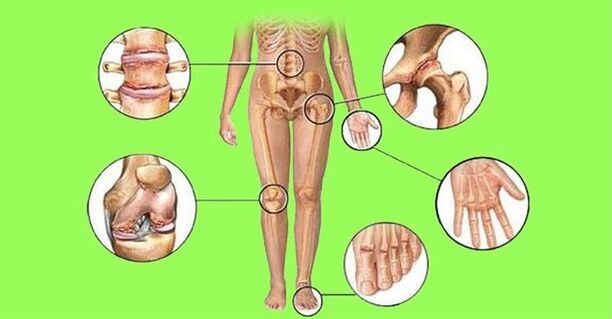What is the difference between rheumatoid diseases and each other? How to detect problems in time?
Rheumatoid arthritis is a systemic inflammatory disease of the connective tissue, in which the patient affects small joints (elbows, knees, hands and feet) in a destructive-erosive type. The result is bone erosion and subsequent deformation. Over time, the symptoms of the disease worsen and lead to disability. About 60 million people in the world suffer from this disease. The disease is more common in women, whose average age is from 30 to 35 years.

Rheumatoid arthrosis is a disease that affects the cartilage tissues of the ankles, knees, shoulders, hip joints and feet. The progressive form progresses to osteoarthritis, which creates a restriction on a person’s motor activity. The disease can develop in two symmetrical joints at once. Sometimes in different, for example, knees and hips on one limb.
Rheumatoid polyarthritis is a real problem of modern rheumatology. The disease, in addition to the joints, spreads to internal organs and muscles. The disease develops symmetrically on both arms or legs. The disease often leads to disability.
Rheumatism affects the connective tissues of the cardiovascular and musculoskeletal systems, the knee joints, elbows, ankles, and the heart itself. Locally, the disease can affect a person’s internal organs and systems. This disease requires timely treatment. If this is not done, then there will be complications with fatal outcomes.
The main difference
Sick people come to the doctor with complaints of discomfort in the joints, pain and limited mobility. The symptoms of arthritis and arthrosis are similar, but there are characteristic differences.
arthritis changes:
- synovial membrane with fluid, joint capsule becomes inflamed;
- haba;
- redness in painful areas;
- two joints ache at the same time;
- no joint deformity.
Cartilage inflammation starts from infection, injury or disruption in metabolic processes.
Physiology of arthrosis:
- modified joints;
- prone tissue thirsts with age;
- inflammation, swelling and redness were not observed;
- normal temperature;
- only one joint was affected.
The disease brings suffering to a person when performing simple actions: bending, bending, straightening, lifting a leg or arm. The patient barely sat on the chair, down the stairs.
Signs and symptoms
The disease has common symptoms:
- difficulty walking;
- the presence of pain in the inflamed area;
- poor mobility of problem areas.
The normal way of life of sick people is disturbed. Every morning, getting out of bed, you have to "disperse" to go to the kitchen, overcoming the pain.
What is more dangerous
The disease brings a lot of pain and distress to the patient.
Arthritis occurs as a result of inflammation in the body. She is being treated. It is important to contact a specialist in time, and not wait for bone erosion and other complications.
Arthrosis is a "disease of the elderly" with changes in the joints. Thirsty cartilage thins. Synovial fluid, which is a source of tissue nutrition, is not restored. The consequences of this disease are irreversible. To alleviate the condition a person can be a specialist who will establish the diagnosis and prescribe treatment.
Diagnostics
It consists of performing various procedures and activities. During the examination, the doctor learns from the patient with arthritis information about past infections and injuries. Determine the course of the disease and set diagnostics:
- Blood tests for the detection of uric acid.
- Ultrasound of the joints.
- X-ray of the affected area.
- CT.
- Arthroscopy.
The results show a complete clinical picture of the disease.
Step -by -step diagnosis of arthrosis:
- Visually, the doctor assesses the mobility of the joint. Whether an ossified area is observed or not in the problem area, whether a buzzing is heard. What is the condition of the muscles around a sore joint?
- Bone growth and joint deformities help to see x-rays.
- Analysis and histology of synovial fluid.
- Complete blood count.
Physical training
I would like to note that exercise therapy, swimming - effectively help in the prevention and treatment of arthrosis. Physical activity aims to restore joint mobility. Increasing the movement of blood flow in the affected area stimulates the cleansing and repair of joint tissue.
We must not forget about the limitations of physiotherapy training:
- It is performed during the remission period in the absence of severe pain.
- In old age, a group of pre -existing diseases or serious deterioration of the joints does not allow doing physical exercise.
- Overweight patients are allowed to perform limited exercise without serious load.
- The effect of exercise therapy is regular exercise, alternating with periods of rest for the joints.
Rheumatoid disease is treated by rheumatologists and orthopedic traumatologists. Early diagnosis and proper treatment will allow you to live without complications. Patients who seek help in a timely manner will have the opportunity to continue to exist normally. With arthrosis, this relieves the condition, stopping the progression of the disease. And most importantly, don’t be flawed.


























